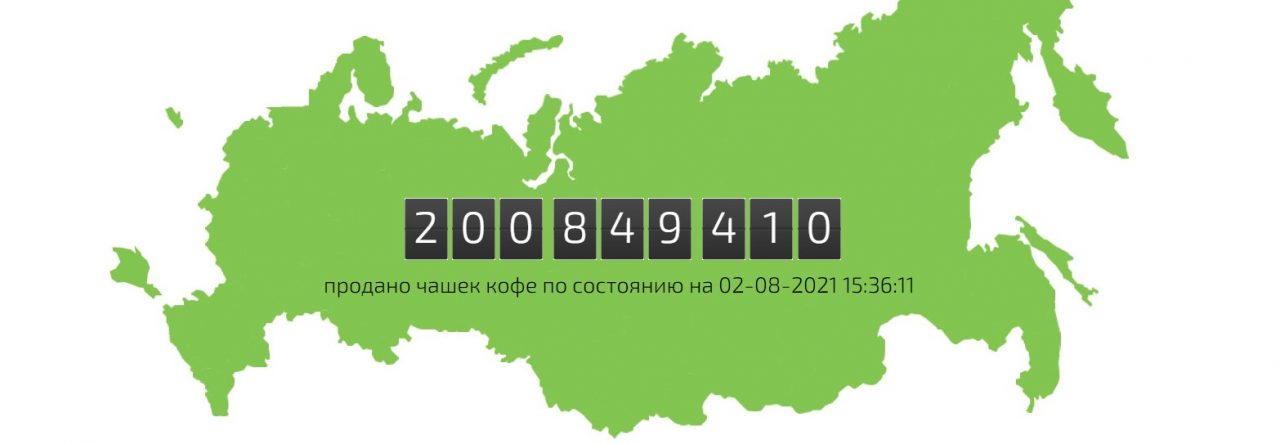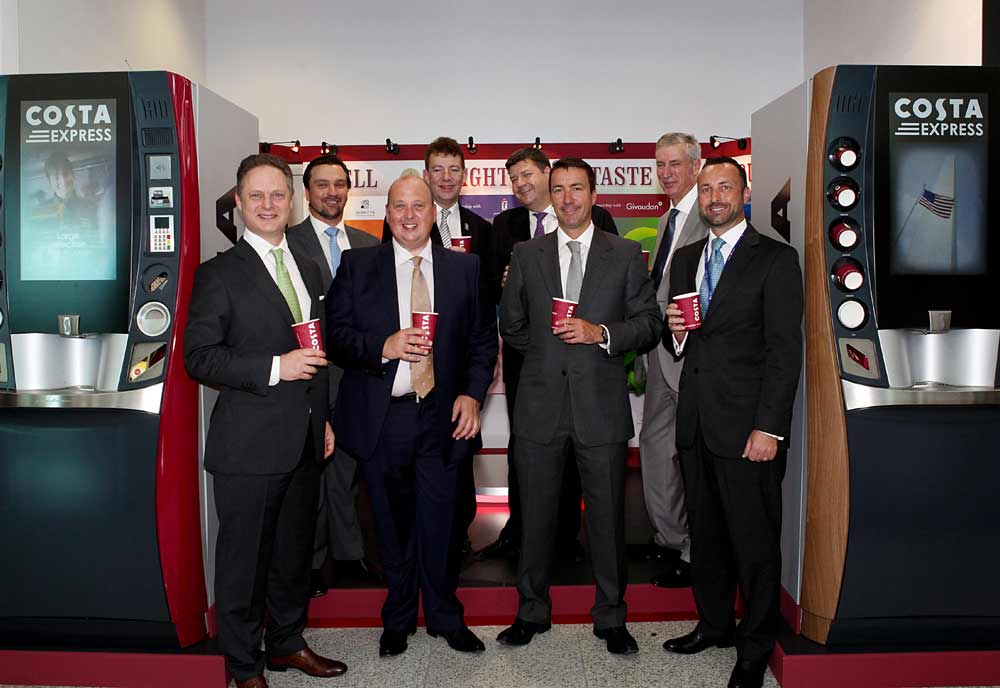In 2011, Costa Coffee, the second largest chain of coffee shops, decided to expand its portfolio and hit the vending area.
The movement in the new direction began with the acquisition of the Coffee Nation chain – thus Costa Express brand was born. Costa decided not to lose time and quickly started to transform the quality of vending coffee to new heights.
The main tool for the breakthrough was going to be a new approach to the implementation of the vending machine itself to make it an example of all that people usually invest in the concept of “innovation”.
Brewing high-quality coffee “from-grain-to-the-cup” via the vending machine – it’s a constant challenge. At some stage it was even a challenge to the very common sense. Getting a consistently high level of quality in the long run was not allowed by the specific historical moment’s technology.
The “Marlow Project” team
Meanwhile, people got used to the quality level of coffee as “brewed by barista” and such a request could not be canceled. Costa had to ensure quick brewing of high-quality coffee, considering the relevant requirements as to its temperature and as to the level of freshness of milk that is added in some particularly popular drinks. And of course not to forget about such “trifles” as hygienic and sanitary requirements, economic feasibility and reliability of the machine in terms of different operating conditions, that goes without saying.
It’s just how they joked once in the late 90s KVN stand-up playing with Russian word for “the lungs” which is synonymous to the adjective “easy” – “Now that’s the task coming from the bronchial tubes! – Yes, of course, it’s not one of the lungs!”.
Well, what else can it be but not easy? The owners of the company aimed to the conquest of international markets. Making it with a trivial device that’s present in any business center or shopping mall from Lisbon to Vladivostok is impossible – how you will be different from what is already present in the local markets?
Thus “Project Marlow” was born aiming at a complete revision of the whole coffee vending in the direction of “intelligent supervending”, how the company puts it.
Objectives: to establish an internationally scalable chain of coffee machines with low maintenance requirements in the field, the highest level of software functionality and latest user interface as well as control systems that can be managed and upgraded remotely. Requirements to the functional part of the machine regarding consumer – 240 options of hot and cold drinks based on coffee, tea and milk (this is all possible with different flavors, syrups, volume varieties and other characteristics), mobile and non-cash payment options, dynamic HD-graphical interface etc.?Costa immediately realized that it will not achieve these ambitious targets alone, by itself. As a result, a program was launched to attract the leading developers in their respective segments for creation of a combined solution that satisfies all the requirements of company’s shareholders and consumer expectations.
The “Marlow Project” team includes the following players and their cutting-edge competence.
First of all, Intel, supplier of Intel® CoreTM i7 chip and a designer of solution’s concept with a minimum of moving parts for durability and endurance – the device has Solid State hard-drives. The estimated period of physical and moral deterioration of the final product (which is an up-to-date vending machine) – 7-8 years. Each unit has an Intel® Audience Impression Metric Suite (AIM Suite) installed which helps each individual unit to produce patterns of work (including the demonstration of entertainment content during the time of inactivity) in accordance with the “habits” of the local customer base – the daily fluctuations, the most popular products, etc.
All components are managed via Active Management Technology (AMT) centrally. Intel says that the system is developed by the same team that was engaged in creation of management and control system for the Rolls-Royce engines.
Further on, Italian designers Pininfarina (permanent contractors for Ferrari and Maserati) were employed, as well as a Swiss maker of coffee brewing hardware – Thermoplan, and – you will be surprised – eMixPro (the company that produces signature sound for U2, Cold Play and even Rolling Stones).
The last details of this portrait were added by a web design company Atomhawk (responsible for the corporate identity of the Harry Potter brand on the Internet). Contactless and cashless payments were provided by SIX, Swiss payment service of the national stock exchange.
Pretty impressive, shall we say.
Project also involves the leading perfume market players (Givaudan and Scentys) as it doesn’t want to forget about the aroma marketing. Its system integrator is Bsquare company, which was supposed to bring all the components together in 6 (!!!) months starting from the first project-related meeting. Already during the test phase the level of general acceptance by the consumer after the first episode of use of the product was 95%.
The user interface is based on the Windows® Embedded Standard 7 and supports multi-touch on the surface area of 28 inches with the implementation of all relevant security protocols, as well as taking into account the requirements of the project in terms of remote service – telemetry system has web-based interface for centralized Costa Express back-office access. The company’s managers get great opportunities in terms of the analysis of all aspects of the machine’s performance described by various sets of data: the exchange is carried out within the standard DEX (Data EXchange). So far it is supposed to process the data for sales and inventory to ensure timely pre-loading of consumables and raw materials, alerting the machine components’ breakages and reaching the maximum loading with the cash.
It is clear that on the basis of these (and many others) data-sets operators will have ample opportunities for proactive machines management from logistics to (future) dynamic pricing, providing discounts on bulk of orders within a one-time payment, giving out the coupons, etc.
One of the most important components – rebooting the whole machine by one touch of a button with a full system recovery from the last saved version of the operating parameters in the event of system’s crash. The parameters are stored in the cloud and are accessible at any time, via a working telecommunications channel. «Keep it simple» approach in all its glory.
The first stage of exploitation of the working solution delivered 24 hours of continuous operation and 800 cups of coffee beverages from the machine launched specifically for the retail trade show in New York. After that these really interesting machines started their march around the world. We have to give it to them – apparently it’s a real monster in the positive sense of the word. Very nice, attractive and smart design: the company knows that a consumer who could not understand how to act to obtain the desired result in the first 30 seconds is likely to quit trying and leave.
Therefore, the interface is designed in a manner that we can only describe as a “delicious” one. Even the most “unsophisticated” people could manage in less than 30 seconds which is critical for this type of machines. Moreover, if the vending machine doesn’t receive the level of attention that it deserves for a long time it activates consumers’ attraction regime – special graphics and videos will conquer the attention not only of the children – they are excellent to entertain the adults as well. Bravo, in an age of interactive video content such approach is everything, call it dynamic branding, call it whatever you like, the main thing is that works.
If really fresh and quality ingredients are used – coffee blends, milk, cocoa and chocolate, syrups – the results get really impressive. Thermoplan makes great “grain-to-cup” machines enabling them with smart stuffing and brilliant outer wrapper – product of a premium level. Not surprisingly, the company abandoned the initial volume of the deployment of new machines in the direction of … in the direction of its increase, of course.
2000 new vending machines all over the world have turned to 20 000. Strategic directions – gas stations, transportation hubs, office spaces, shopping malls and parking lots, even libraries and, of course, cinemas and sports facilities.?20000 high-tech devices around the world – it’s an ambitious plan, project of the century, soviet era GOELRO-like plan applied to the coffee industry.
I venture to suggest, however, that in some countries the company still will be facing a number of challenges in terms of implementation of all the potential inherent in the solution. The obstacles can be anything you like – from the communication channels for quality and uninterrupted information exchange to logistics in the supply of consumables, quality service staff (even such remote-enabled solutions will need it), and so on.?And here’s the crucial point – the presence in different regions of the planned development of local partners who will have the competence and capability of providing a decent level of Costa Coffee product support on both the «know-how» and resources levels.
RusHOLTS in this regard is ready to provide such projects with more than worthy of support thanks to the capacity of its Monitoring Centre, not to mention the experience of organizing the supply of each component for the successful organization of quality remote control of coffee brewing at large distances.?Our gas stations competence is based on the work of the whole Russia scale, and our experience has gone “through the years and distances” with us and can not be overestimated. As well as the potential benefits for Costa.
* GOELROfirst-ever Soviet plan for national economic recovery and development of electrification)




Leave a Reply